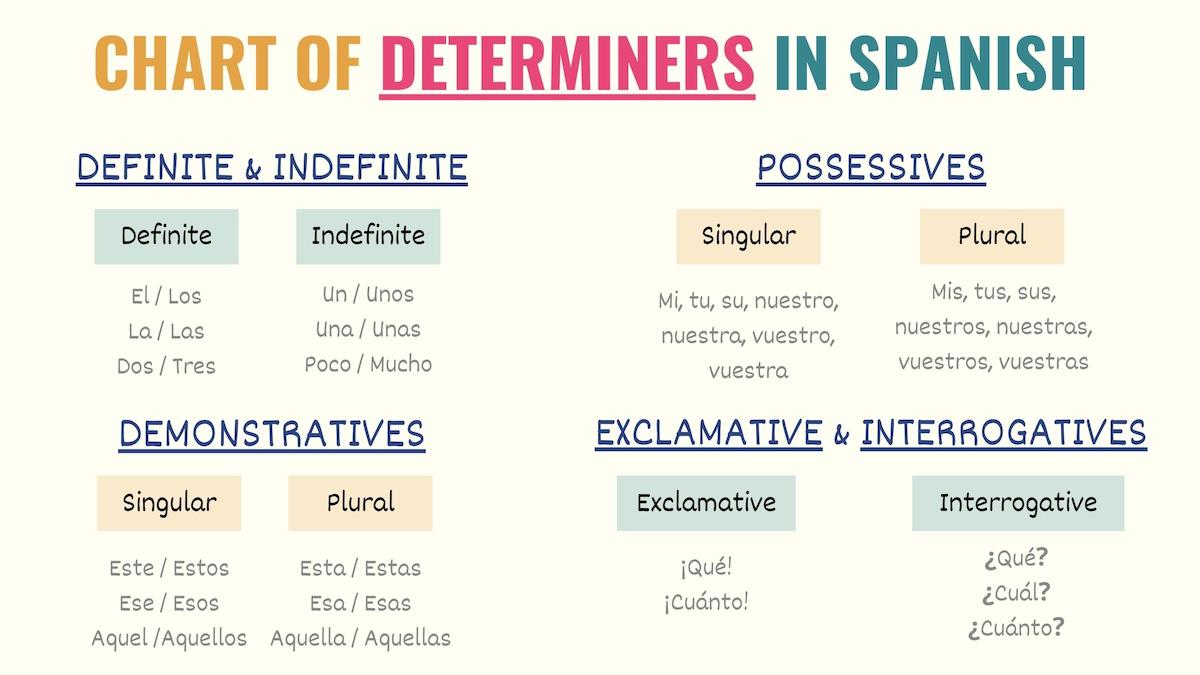Spanish determiners, also called determinatives, are words that describe or identify a noun. Simply put, determiner words clarify what a noun is referring to and indicate its quantity. Spanish determiners always come before nouns and mark gender and number.
Sounds familiar? Determiners are a part of speech in Spanish, meaning that they’re essential to form sentences. So, in this guide, you’ll learn the different types of determiners in Spanish. Here is what we’ll cover:
- Possessive Determiners
- Demonstrative Determiners
- Spanish Definite Determiners
- Indefinite Determiners in Spanish
- Interrogative & Exclamative Determiners
- Key Points
- Downloadable PDF
Many of these names may sound familiar to you. In the following sections, I’ll provide you with examples of these Spanish determiners.

Take Note: Because they work with them, Spanish determiners must agree with the noun’s gender and number. So, you should get familiar with the determiners’ masculine, feminine, singular, and plural forms.
Spanish Possessive Determiners
As its name suggests, Spanish possessive determiners are words we use to express ownership or possession. To put it simply, possessives clarify that a noun belongs to someone. They’re also used to talking about family and relationships.
Examples of Spanish possessive determiners are:
- Mi, mis – My
- Tu, tus – Your
- Mío, mía, míos, mías – Mine / My
- Su, sus – His / Her / Your (formal you)
- Nuestro, nuestros, nuestra, nuestras – Our
And here are some sentences using Spanish possessives:
Ella es mi hermana.
She is my sister.
Nuestros zapatos son azules.
Our shoes are blue.
¿Cómo estás, amigo mío?
How are you, my friend?
Sus perros son muy bonitos.
Her dogs are very cute.
Spanish possessive determiners are classified into non-stressed (don’t have gender) and stressed (do have gender). To learn the specific rules for these determinatives, you should check this guide on Spanish possessives.
Take Note: Spanish possessives are also called possessive adjectives because, like descriptive adjectives, determiners also modify a noun.
Demonstrative Determiners in Spanish
Spanish demonstrative determiners clarify the spatial or temporal distance between a noun and the speaker. Demonstratives in Spanish have gender and plural forms.
Examples of Spanish demonstrative determiners are:
- Este – This
- Ese – That
- Aquel – That
And here are some sentences using demonstratives:
[Demonstrative] + [noun]
Esa chica es su novia.
That girl is his girlfriend.
Me gustan estos zapatos.
I like these shoes.
Aquellas casas están vacías.
Those houses are empty.

In my guide to Spanish demonstratives, you can learn the difference between este, ese, and aquel.
Spanish Definite Determiners
Spanish definite determiners identify a noun more precisely. Definite determiners express amounts or how specific a noun is. Simply put, we use these words to express that we’re talking about a specific thing, concept, or person.
Examples of Spanish definite determiners are:
- El / Los – The (masculine)
- La / Las – The (feminine)
Spanish numbers (ordinal and cardinal):
- Un, dos, tres… – One, two, three…
- Primer, segundo, tercero… – First, second, third…
Check these examples:
[Definite determiner] + [noun]
Me gusta el carro rojo.
I like the red car.
Las flores son de Dalia.
The flowers are Dalia’s.
Hay doscientas sillas en la sala.
There are two hundred chairs in the room.
Take Note: When working as determiners, certain numbers in Spanish have gender.
Spanish Indefinite Determiners
Indefinite determiners in Spanish identify the noun in a more imprecise and undefined way. So, these words allow you to refer to nouns without being too specific about their amount or without talking about a specific thing or person.

Below are some examples of Spanish indefinite determiners.
- Un / Unos – A / An / Some (masculine)
- Una / Unas – A / An / Some (feminine)
Indefinite quantifiers:
- Algún, alguna – Some / Any
- Bastante, bastantes – Enough / Too much / Quite
- Cualquier – Any
- Demasiado, demasiada – Too many / A lot
- Mucho, mucha – A lot / Many
- Ningún, ninguna – None / Not any / Not a single
- Otro, otra – Other / Another
- Poco, poca – Few / Little / Not much
- Tanto, tanta – So many / So much
- Todo, toda – Every / Each / All
Notice that none of these words provide concrete information about the noun. Check these examples:
[Definite determiner] + [noun]
Usa cualquier vaso.
Use any glass.
Tenemos pocas verduras.
We have a few vegetables.
Hay unas niñas en el jardín.
There are some girls in the yard.
Exclamative & Interrogative Determiners in Spanish
When learning Spanish question words, you’ll learn that some interrogatives always come before the noun. We call these interrogative determiners in Spanish and use them to inquire about a noun.
On top of being used in questions, some of those words are also used to intensify a noun. In this context, they’re called exclamative determiners.
Here are some examples of exclamative and interrogative determiners in Spanish:
- ¿Qué…? – What…?
- ¡Qué…! – What…! / So
- ¿Cuánto…?* – How much…? / How many…?
- ¡Cuánto…!* – How…! / So much… / So many…
- ¿Cuál…? – What…? / Which…?
Note: ‘¿Cuánto?’ and ‘¡cuánto!’ are the only interrogative and exclamative determiners that change to mark the number and gender of the noun.
[Interrogative/Exclamative] + [noun]
¡Qué casa tan bonita!
What a beautiful house!
¿Qué carro te gusta?
What car do you like?
¿Cuánto dinero traes?
How much money do you have?
Key Points
Spanish determiners are crucial to building coherent sentences. As a result, in this guide, you learned the different types of determiners in this language. Here are some key points to keep in mind:
- Determiners are words that identify and provide more information about a noun.
- Spanish determiners are always placed before the noun. Stressed possessive determiners are the only exception to this rule for emphatic purposes.
- Most determiners in Spanish mark the gender and number of the noun they work with.
- Depending on the information they convey, Spanish determiners are classified into:
- Possessives: Express that a noun belongs to someone or something.
- Demonstratives: Demonstrate how far the noun is in relation to the speaker.
- Definite: Identify a specific noun. Definite articles and numbers are examples of these determinatives.
- Indefinite: Refer to a noun in an imprecise way. Spanish indefinite articles and quantifiers are examples of this type of determiner.
- Exclamative & Interrogative: Inquire or emphasize information about the noun. Some question words in Spanish can work as a form of determiners.
Take Note: Often, people confuse some determiners with adjectives because they both modify the noun. Spanish adjectives express the characteristics of a noun. On the other hand, Spanish determiners identify, intensify and are placed before a noun. Unlike adjectives, determiners can be used as pronouns in Spanish.
Download the Spanish Determiners PDF
Spanish grammar topics such as determiners can take a while to learn and truly understand – especially with all the different types of determiners. So, I’ve created this PDF with the graphics for the different types including demonstrative determiners, definite and indefinite determiners, as well as the key points for them.



